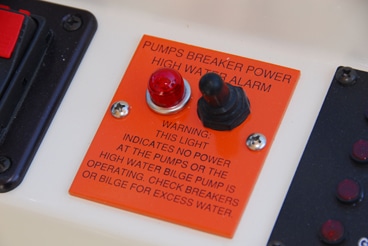
Sailboat Alarm Systems
Testing your sailboat’s alarms is as important as having them. After all, if you can’t be absolutely certain that an alarm will work when it’s needed, then it’s of little use.
After smoke, carbon-monoxide, and high-water alarms, it’s likely that the engine’s low-oil-pressure alarm is among the most important in your quiver of vessel alerts. An engine can be seriously or irreparably damaged if it’s run without oil pressure for just a few seconds. Fortunately, this alarm has its own built-in test feature that’s activated with each start-up. If the alarm sounds with the key on and the engine not running, then goes silent when the engine starts, all is working properly. Once the engine has started and oil pressure has silenced the alert, then, assuming that the wiring and components are sound, only one thing can trigger this warning signal: low or no oil pressure. Simple—and critical—as this system is, I’m amazed at how many of the vessels I operate have no working low-oil-pressure alarm. On your own boat, if you don’t hear that alarm on start-up, troubleshoot the reason immediately, as you’re running without protection from this potentially catastrophic engine killer, the lack of lubricating oil.
I suspect that exhaust-temperature alarms have saved more engines or exhaust systems than any other single device. Because they’re very sensitive and quick acting, typically triggering at a mere 165 F, they sound long before the engine’s own high-coolant-temperature alarm goes off. To verify that this alarm is working properly, make sure it’s included in your routine maintenance schedule. The test is relatively simple; it requires a heat gun and an infrared pyrometer. Activate the alarm by turning the key to “on.” Note: It doesn’t matter if the engine is running, but it’s safer and easier if you carry out the test with it off. With the key turned to “on,” carefully apply heat to the alarm transducer, starting from a distance so as not to damage it, while monitoring it with the infrared pyrometer. The alarm should sound when the temperature of the transducer reaches its manufacturer’s trigger point. If it fails to sound even when exceeding this temperature by 10 percent, a problem that requires some troubleshooting probably exists.
High-water alarms are infrequently tested, and when they are, the test often consists of simply lifting the float switch to see if the warning sounds. Testing an alarm system as important as this one requires a scenario that comes as close to a real-world flooding as one can get without actually placing the vessel in danger.
You can do this by actually filling the bilge with water via a garden hose. This will likely require disabling the bilge pump. Once the alarm sounds, reconnect the pump and allow it to remove the water. If you want to test the pump’s capacity, and you should, fill the bilge via 5-gallon buckets so you’ll know how much water the pump is removing. By recording the time it takes for the pump to empty the bilge, you’ll be able to calculate the pump’s actual versus its rated capacity.
By listening for your low-oil-pressure alarm with every start-up and by testing other alarms at least annually, you’ll earn yourself the greater peace of mind that comes from knowing that these warning systems will work if and when they’re needed.
Steve D’Antonio offers services for boat owners and buyers through Steve D’Antonio Marine Consulting.








